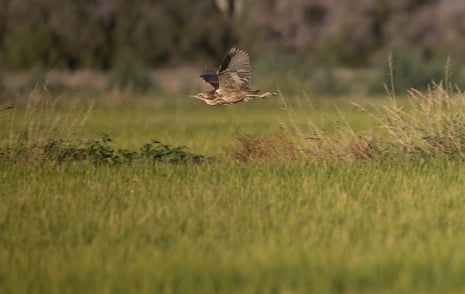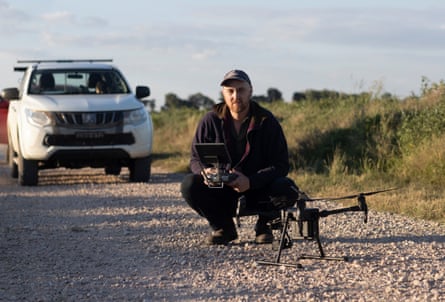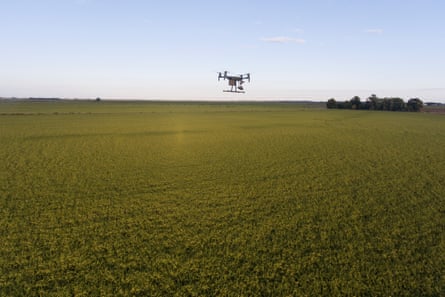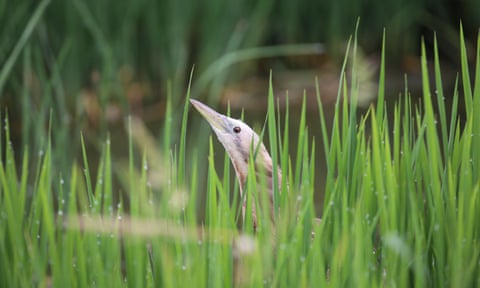Rice farmers and ecologists in south-west New South Wales are weaving new partnerships between agriculture and wildlife conservation in efforts to rescue a little-known waterbird with a mysterious story.
But pressure from the water market, crop competition and, ironically, increasing water efficiency, could pose a threat to their efforts.
Third generation rice farmer Wayne Andreazza remembers when he first started hearing the foghorn-like call of the “bunyip” bird in the early mornings and evenings at his property in Griffith, NSW.
“I didn’t really know what it was,” he said.
“I’d be doing my watering and I’d hear this loud booming sound – it was amazing. I always wondered what it was.”

Andreazza has been part of the Bitterns in Rice project for three years. The program’s aim is to ensure the survival of the Australasian bittern and is funded by the Riverina Local Land Services (LLS) through the National Landcare Program.
“Male bitterns make deep, booming calls when searching for mates,” project ecologist Matt Herring said.
“It’s believed Aboriginal Australians heard the calls and connected them to the myths of the bunyip, which is how it got the nickname.”
The mythical bunyip was said to lurk in swamps, marshlands and riverbeds waiting to pounce and eat wandering children or oblivious adults.
There are differing stories of the origins of the bunyip. Some say it was a punisher of evil against the environment and wildlife. Others say it was a blood-thirsty killer.
But the reports of the booming or roaring calls of the bunyip right before it would attack were most likely those of the stealthy bittern hiding in the grass.

With fewer than 2000 birds left across Australia, New Zealand and parts of New Caledonia, about 750 of these endangered waterbirds call the rice fields of the Riverina home.
Twelve years ago, with the help of Herring, farmers began to investigate how the elusive birds were using rice fields as nesting grounds to fledge their young.
Herring began approaching individual farmers who were willing to make their land inviting for bitterns to nest.
This meant conserving grassy banks for the birds to hide in, controlling predators and putting on early season permanent water.


“We developed an incentive program to bring together all the rice farmers who already had a rapport with the bitterns,” senior land services officer Anna Wilson said.
“What we ask is a few simple things to do to tweak the environment to suit bitterns. The main thing is early permanent water, because without it the whole program falls apart. The bitterns need 140 days of water [a year].”
While many rice growers have now moved away from permanent ponding to grow rice, Andreazza and his family continue to farm traditionally. In October they flood their rice with water for roughly five months to accommodate the bitterns nesting and fledging period.
“You are basically mimicking a wetland,” he said. “We grow 1500 acres of rice and we do it on all the farms.”
Thanks to farmer enthusiasm and good rains from La Niña, the past three years have been the most successful for the project to date, with 1885ha of land made available for bitterns to nest in the 2021-22 season.
But Herring said while this is good news for bitterns now, external pressures on growers to transition to less water-intensive methods of farming threaten the long-term survival of the birds.

“Water-saving growing methods have an insufficient ponding period for the bitterns to breed successfully,” he said.
“This is a real threat to the species.
“We are doing everything we can to at least maintain some proportion of the rice area having early ponding … but to expect the entire rice growing area to farm in a bittern-friendly way now is unrealistic.
“The water is worth just too much money and there is too much competition with cotton and almonds and other crops.”
Herring said the bitterns project is proof that agriculture and conservation can work together for mutual benefit, and people should be open to supporting it with their hip pocket.
“In the long term, it’s the consumer that ought to pay for bittern-friendly rice,” he said.
“I like the idea of the public voting with their spending. If we want to see conservation efforts in farming, we need to pay for it. People do it with coffee and tuna so why not the bittern?”
Andreazza says the collaboration has not only been beneficial to the bitterns.
“Every kind of duck and bird and frog comes in and it’s hard to put into words how it feels … Unless you experience it for yourself, it’s just unbelievable.”
Kat Vella is a Griffith-based freelance journalist.
